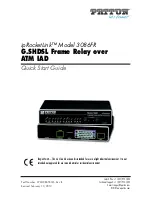
INS_CWGE24MS2_REV–
10/05/16 PAGE 136
INSTALLATION AND OPERATION MANUAL
CWGE24MS2
TECH SUPPORT: 1.888.678.9427
ERPS
Introduction
The ITU-T G.8032 Ethernet Ring Protection Switching feature implements protection switching
mechanisms for Ethernet layer ring topologies. This feature uses the G.8032 Ethernet Ring
Protection (ERP) protocol, defined in ITU-T G.8032, to provide protection for Ethernet traffic in a
ring topology, while ensuring that no loops are within the ring at the Ethernet layer. The loops are
prevented by blocking traffic on either a predetermined link or a failed link.
The Ethernet ring protection functionality includes the following:
» Loop avoidance
» The use of learning, forwarding, and Filtering Database (FDB) mechanisms
Loop avoidance in an Ethernet ring is achieved by guaranteeing that, at any time, traffic may
flow on all but one of the ring links. This particular link is called the ring protection link (RPL) and
under normal conditions this ring link is blocked, i.e., not used for service traffic. One designated
Ethernet ring node, the RPL owner node, is responsible to block traffic at one end of the RPL.
Under an Ethernet ring failure condition, the RPL owner node is responsible for unblocking its end
of the RPL, unless the RPL has failed, allowing the RPL to be used for traffic. The other Ethernet
ring node adjacent to the RPL, the RPL neighbour node, may also participate in blocking or
unblocking its end of the RPL.
The Ethernet rings could support a multi-ring/ladder network that consists of conjoined Ethernet
rings by one or more interconnection points. The protection switching mechanisms and protocol
defined in this Recommendation shall be applicable for a multi-ring/ladder network, if the
following principles are adhered to:
» R-APS channels are not shared across Ethernet ring interconnections;
» on each ring port, each traffic channel and each R-APS channel are controlled (e.g., for
blocking or flushing) by the Ethernet ring protection control process (ERP control process) of
only one Ethernet ring;
» Each major ring or sub-ring must have its own RPL.
In an Ethernet ring, without congestion, with all Ethernet ring nodes in the idle state (i.e., no
detected failure, no active automatic or external command and receiving only “NR, RB” R-APS
messages), with less than 1200 km of ring fibre circumference and fewer than 16 Ethernet ring
nodes, the switch completion time (transfer time as defined in [ITU-T G.808.1]) for a failure on a
ring link shall be less than 50 ms.
The ring protection architecture relies on the existence of an APS protocol to coordinate ring
protection actions around an Ethernet ring.
The Switch supports up to six rings.
Guard timer -- All ERNs use a guard timer. The guard timer prevents the possibility of forming
a closed loop and prevents ERNs from applying outdated R-APS messages. The guard timer
















































